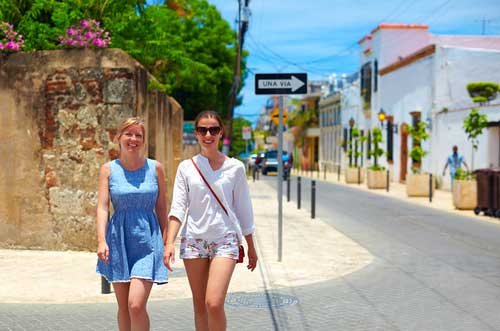Book an Exclusive Private Experience with your personal guide and driver for a full day.
Stroll around the first European Colonial city in the New World and admire its historical buildings. Originally located on the east bank of the Ozama River, it was the first city built by the Spaniards during the American colonization.
Santo Domingo is the first city in the American continent. It was declared World Heritage Site by the United Nations back in 1990, due to its historical importance and impeccably cared for buildings and streets.
Book this custom experience and get to know one of the most beautiful and historically rich cities in the world.

[formassembly formid=4986537]
The Oldest City in America: Santo Domingo
Founded by Bartolomé Columbus in 1496, the city of Santo Domingo was almost completely built during the 16th century.
Even though many other countries have colonial areas, where the first Europeans settled; the city of Santo Domingo’s historical importance is incomparable.
Walking through the gorgeous streets of the colonial zone, you’ll discover buildings from the early 1500s, such as the Alcázar de Colón, the Primada Cathedral or the Ozama Fortress, among many others.
The Experience: Colonial Town daytrip
Your private driver+tour guide will pick you and your group up at the resort at 09:00 if coming from Punta Cana or 10:00 from La Romana or Bayahibe.
Santo Domingo is a two-hour drive from Punta Cana or a 1.5-hour drive from La Romana or Bayahibe.
Enjoy the beautiful scenery as you get closer to our beautiful capital city along the seaside Autovia del Este, the road that connects Punta Cana to Santo Domingo.
Once you arrive at the colonial zone (before lunch time) your driver will drop you and your guide off in the colonial zone, to start the walking tour.
You can have lunch at one of the many Dominican and international restaurants located in the colonial zone. We recommend the restaurants in Plaza de La Atarazana.
La Atarazana looks over the Columbus House (Alcázar de Colon) and is a European style walking street that hosts several restaurants ranging from Spanish cuisine, to Italian, Dominican, as well as bars and coffee shops.

Monuments and Sites to Visit: Santo Domingo Colonial Town
The private tour is completely flexible, you may speak to the tour guide on the way to the city in case you want to modify the itinerary. The tour contemplates but is not limited to the following monuments / sites:
In 1714 the construction of the church began with the permission of the Archbishop of Navarrete and with money donated in 1683 by Don Jeronimo de Quezala and Garcon .
The church was opened for worship without being completed around 1743 . The conclusion is around 1755. The church built by the devotion of San Ignacio .
Built in 1823 by Governor Geronimo Borgellá, served as seat of
government, building brick double gallery of view, similar to Alcazar
de Colon. In 1844 worked the Court; 1942 to 1960 was the seat of
the Senate, and in the showroom 1978 the High School of Painting
and Sculpture. Ordered built by Diego Columbus in 1514.
Colonial is a sector means: Shipyard, arsenal, deposit. Today home
to restaurants, boutiques and art houses.
Built in 1823 by Governor Geronimo Borgellá, served as seat of government, building brick double gallery of view, similar to Alcazar de Colon. In 1844 worked the Court; 1942 to 1960 was the seat of the Senate, and in the showroom 1978 the High School of Painting and Sculpture.
Ordered built by Diego Columbus in 1514. Colonial is a sector means: Shipyard, arsenal, deposit. Today home to restaurants, boutiques and art houses.
Meridiana: placed in front of the Government Palace in 1753 by order of Governor Francisco Rubio and Penaranda, General Commander of the time. Direct vertical type is east and west, the east side shows the morning and west in the afternoon hours.
Its slope is the product of the need for judges of the Royal Audiencia could see the time from their windows.
The construction drawings based on the architect Alonso de Rodríguez started in 1514 by Pope Julius II ; unemployed work continued with a new design by Luis de Moya and Rodrigo de Liendo in 1522 with the intervention of Bishop Alexander Geraldini .
The architect Alonso González , inspired by the Seville Cathedral, the church concluded partially in 1540 .
Successively Fuenmayor Alonso gave impetus to the work and 31 August 1541 was consecrated .
In 1546 Pope Paul III elevated it to the rank of ” Metropolitan Cathedral and Primate of America.” Another promotion came in 1920 when Pope Benedict XV raised to ” Minor Basilica of Our Lady of the Annunciation ” .
In the second half of the sixteenth century , on the south side was built Cloister sector with the canonical cells , another example is the Cathedral of Salamanca in Spain .
In 1547 the work is interrupted bell tower, because its height surpassing the Torre del Homenaje, riots had sentries . Headquarters was the Sir Francis Drake troops during their invasion of 1586 , who sacked .
Casa del Cordón is a building in the city of Santo Domingo in the Dominican Republic.
It was the first stone house in America and probably the first two story house. Its name comes from the cord that comes in its facade, which is associated with the Franciscan order. It is located in Isabella Street corner with Emiliano Tejera.
The house of Rodrigo de Bastidas was built next to the site of the keep which Ovando rose, early sixteenth century.
Bastidas, founder of cities in the South American coast, like Santa Marta, conqueror and assistant mayor of the town of Santo Domingo, was one of the first to get rich with the treasures of America.
After his tragic death in 1527, on the island of Cuba, the house was occupied by his son Rodrigo de Bastidas Bishop and grandson of similar name.
Founded in 1551 Bishop of Bastidas primogeniture, the house was used for over a century by the family and heirs of the first advance.
Built in 1520, composed of the Palace of the Captains General of the Colony, which was the residence of the Governor and the headquarters of the Royal Court, first in America.
Restored and converted into a museum in 1976, on the occasion of the visit of King Juan Carlos and Sofia, a fact which was a historic event, being the only Spanish royalty since since the discovery to set foot in Santo Domingo.
Formerly headquarters Presidential Palace and government offices. Shows great relics of the colonial era of the island to the proclamation of the independence of Spain in 1821, including the only shield in the world of Queen Juana of Castile, who went crazy with the death of her husband, Felipe the Handsome .
Built in 1505, is one of the first houses in the city is named after its owner, Francisco Tostado de la Peña , clerk of the Governor.
Owner of many sugar cane fields , used the first floor to deposit bags. Inherited by his son with the same name and also a writer, poet and former professor at the University Creole Santiago de la Paz, who died tragically in 1586, beaten by a cannonball during the invasion of Sir Francis Drake.
The house was considered the most luxurious of the colony.
Santa Bárbara Built before 1562 , on the mine from which were extracted the materials for the construction of the walls and all the monuments. Built a few years after the Cathedral, under the direction of Father Antonio, which some also attribute the construction of the church of Higuey.
Seriously damaged by the earthquake of 1571, work began again between 1574-1578 . Burned by Drake , in 1586 , and affected by earthquakes in 1673 and 1684.
Las Mercedes.- The priests that arrived on the second voyage of Columbus , brought the picture of the Virgin of Mercy, donated by Queen Elizabeth , image placed on the altar shovel . Built after 1527 , by Rodrigo Gil de Liendo . The work interrupted , was resumed in 1530 and could be completed in 1555 allegedly by help of Carlos V.
The pirate Francis Drake in 1586 attacked it , and the cyclones of 1615 and 1628 destroyed the roof . It was restored in 1635 by Pedro de Portillo , who built the tower and restored the dome, with two arches in blocks, the ship, the foundation of the facade and the frontispiece . In 1673 the chapel dome is crushed by the earthquake.
The legal foundation of this convent is the year 1510. Birthplace of the first University of America, authorized by the Bull ” In Apostulatus Culmine ” of Pope Paul III of 1538 , called St. Thomas Aquinas . In the same place at the end of the nineteenth century , Eugenio Maria de Hostos , founded the first secular school establishment in the city, the National School , where future teachers were prepared .
Church of the former Dominican Convent : The temple of eternal sadness and the most mystical and romantic at the same everything is silent and dark. In this church , Fray Anton de Montesinos , launched the famous Sermon of Advent , cruel and vibrant against aboriginal exterminators .
The construction began in 1511 , during which time Prior was Tomas de Berlanga. The convent was gone and the church was rebuilt in 1746. During Haitian rule served as headquarters , which caused extensive damage.
Queen of the Angels , was built in the year 1560/1564 at the expense of the widow Maria de Arana , pious lady who sold all his property for this purpose.
Here lived the two great poets: the beautiful Leonor de Ovando and Elvira de Mendoza . The General Government Cabral in 1868, granted Father Billini the convent to start Colegio de San Luis Gonzaga, which has seen several famous people.
In the church rests Francisco Xavier Billini, (1837 – 1890) Italian-born priest , who in the last century was the central figure of the charitable life of the island.
Rector of the church , founder of Colegio San Luis Gonzaga , the first House charity in 1867 , the first orphanage in 1869 , and discovered the remains of Christopher Columbus on 10 September 1877 , inventor in 1880 of the Lottery (now National Lottery ), an activity that he used to finance their activities .
In the dome, the church has four paintings : San Mateo, San Juan , San Lucas and San Marcos.
La Puerta del Conde or Bastion February 27 (originally called Bastion of San Gennaro) is a seventeenth century military building consisting of two solid cubes with stone arch between them.
Complete military installation, the wall is part of a triangular-shaped pit facing east and several booths. It served as entrance door to the city of Santo Domingo.
The name is in honor and recognition of Conde Peñalva (Bernardino de Meneses Bracamonte and Zapata), who fought against English invasion of William Penn and Robert Venables in 1655. Long-vacant was transformed into Bullring in 1880. In 1883 the name was changed again to Door February 27.
In 1912 it was converted into a park. In which we find on the floor sculpted in bronze, the wind rose, with the 32 points that divide the horizon. It is from this point that distances on the island are measured (km 0).
Originally called Puerta de Santiago or Puerta Grande, the Puerta de la Misericordia was the first gate in the city wall of Santo Domingo, in the Dominican Republic.
The design was carried out by the architect Rodrigo de Liendo in 1543, who was also responsible for its construction in that same year. During archaeological excavations in 1980, two semi-elliptical forts (small fort) flanking it were discovered.
Near the door is a patio that served as a scaffold to execute those who were sentenced to death.
A small chapel was built in that courtyard.
The door of Mercy, in addition, was the place where Ramón Matías Mella fired the legendary trabucazo of independence at the same time that Francisco del Rosario Sánchez hoisted the Dominican flag, thus declaring the independence of the Dominican Republic after having taken the fortress of Ozama.
Monasterio de San Francisco in Santo Domingo de Guzmán, Dominican Republic, is a monastery that was built between 1509–1560, with the arrival of the Franciscan fathers.
The ruin is one of the most important of the city. It is located in the Colonial City of Santo Domingo and are part of UNESCO’s 1990 declaration of the Colonial City as a World Heritage Site.
The monastery was recognized by UNESCO for being the first and oldest monastery built in the Americas.
The Hospital San Nicolás de Bari is a preserved hospital ruin, and it was recognized by UNESCO for being the oldest hospital built in the Americas.
Construction began in 1503 in Santo Domingo,Spanish soldier, knight, and Governor of the Indies. Only a few years had passed since Columbus was removed from governorship of the island in chains, accused of gross abuses of power.
Columbus was replaced by Francisco de Bobadilla, who was replaced just a few years later by Ovando.
Ovando arrived in Hispanola (now the Dominican Republic) from Spain with 2,500 colonists, including a young Francisco Pizarro, not yet a conquistador. The colony also included the Dominican priest Bartolomé de las Casas who would go on to write about the plight of the natives and African slaves to be amongst the first human rights activists of the new world.
Although this first hospital was founded under his rule, Ovando was no gentle ruler. He is remembered for his ruthless and violent suppression of native uprisings, and for forcing those who survived into a kind of indentured servitude. After his eventual return to Spain, he was replaced by Columbus’ son Diego, whose home, the Alcazar de Colon, still stands nearby in Santo Domingo.
The hospital is named for the famous Saint Nicholas of Bari, Italy whose tomb emits a holy ooze that has been regarded as a cure-all for centuries.
*Entrance to the Cathedral and churches requires covered shoulders and knee-length pants/skirts, for both men and women.
No exceptions are made.
What's Included
- Private roundtrip transportation to and from your resort to Santo Domingo.
- Cold non-alcoholic beverages in the vehicle.
- Wifi on board.
- Entrance to certain monuments (see above).
- Private bilingual tour guide for the day.
- Fuel, tolls, and other parking expenses.
Exclusions
- We offer recommendations for lunch / snacks, but its not included in the rate.
- Significant detours from the route during the transfers.
- Stops of 20’ or more along the road.
- Tips for driver and tour guide.
Private Daytrip Rates
All day-trips are private. Your transportation and tour guide are private (not shared).
Includes vehicle, driver, fuel, tolls, private tour guide and entrance to certain monuments.
This is a full day trip: pickup between 09:00 and 10:00 and return to resort at 19:00-20:00hrs.
From Punta Cana / Bavaro Resort Area
Private Daytrip to Santo Domingo Include Private Driver + Bilingual Tour Guide + Entrance Fees-
1-6 Pax $549
-
7-11 Pax $749
-
12-16 Pax $899
-
17-22 Pax $1099
-
23-40 Pax $1299
-
41-60 Pax $1800



